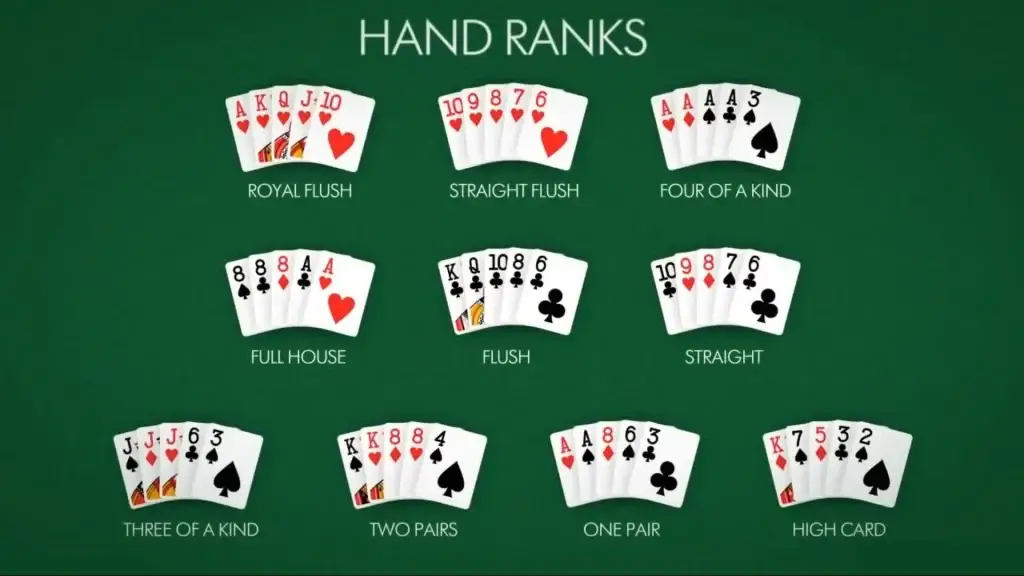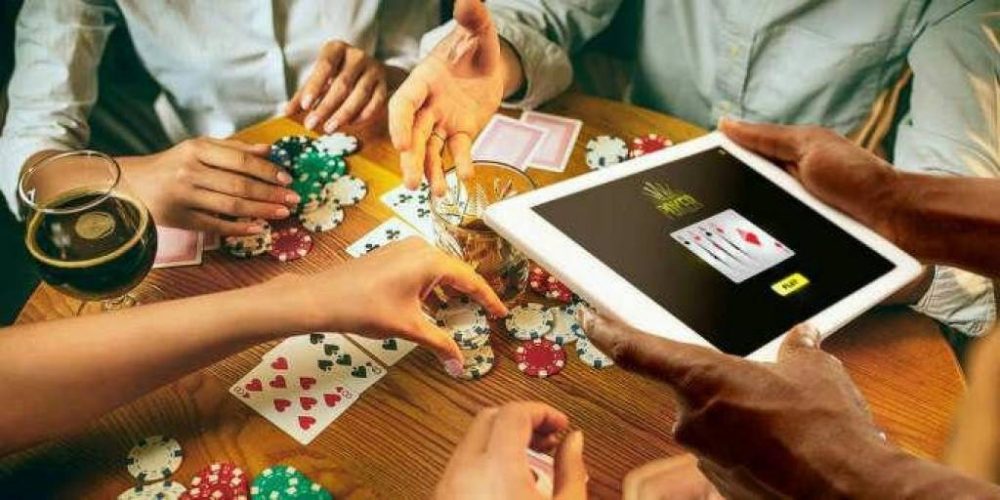Poker is a game in which knowledge of combinations is crucial. It is important to understand how to collect and distinguish combinations in order to act more confidently and effectively. Many beginners get lost in the variety and don’t realise the importance of individual variations.

The basic combinations in poker: from the weakest to the strongest combinations
To navigate the world of card games, it’s important to understand what poker combinations are and how important they are. Let’s take a look at the individual combinations, from weakest to strongest.
- Thehigh card is the weakest combination in poker. If the opponents have no other options, the one with the highest card wins. For example, a King wins against a Queen and an Ace wins against all.
- Pair – two cards of the same value, such as two sevens. A pair is a simple but fairly common variant.
- Two Pairs – two different pairs, such as two tens and two eights.
- Set or Three of a Kind – three cards of the same value. Example – three queens. This combination already shows strength, especially at the beginning of the game.
- Straight – five cards in a sequence, for example 5-6-7-8-9 in different suits. A straight is a strong combination because it is not easy to collect.
- Aflush is five cards of the same suit, such as five hearts. The order doesn’t matter, as long as they are of the same suit.
- Full house – consists of a three of a kind and a pair. For example, three Jacks and two Fours.
- Four of a Kind – four cards of the same value. For example, four nines. This is already a very strong variant, but there are even stronger ones.
- Straight Flush – five cards of the same suit, for example, 7-8-9-10 – jack of clubs. This is practically the pinnacle of skill.
- Royal Flush is the strongest combination in poker. It consists of an Ace, King, Queen, Jack and Ten of the same suit. It is also known as the “dream hand”.
How to Choose Poker Combinations: Secrets of Success
 To be successful, it is important not only to know the combinations, but also to understand when and how to pick them.
To be successful, it is important not only to know the combinations, but also to understand when and how to pick them.
A straight requires a sequence of five cards. For example, if you have a 5 and 6 in your hand and a 7 and 8 on the table, you need to wait for a nine to complete the combination. The probability that the correct card will be revealed must be taken into account: In a standard 52-card deck, there are only four nines left, which corresponds to about an 8% chance of completing the straight if you count the unknowns.
How to get a flush in poker? The secret lies in patience and choosing the right starting hands. For example, if you have two cards of the same suit (e.g. 8 and 9 hearts) and two more hearts on the flop, you have a 35% chance of getting a flush before the river. Use this fact to decide whether you should continue playing or raise. It is important to remember that you can get a flush with low cards if your opponents are not careful enough.
Arack is rarely collected, as it requires four identical cards. For example, if you have two nines and two more nines on the flop, the probability of getting a flush on the turn or river is very small – about 0.2 per cent. If you manage to get a rack, you will almost certainly win the hand if no one has a straight flush or a royal flush. Use this variation for traps, allowing your opponents to raise before you open.
As you gain experience, you will know when and how to take risks in one sequence or another. Knowing probabilities and mathematical expectations will allow you to make better decisions. Patience and analysing the situation is often more important than playing aggressively without calculation.
Combinations depending on the type of poker game you are playing
They are different for Texas Hold’em, Omaha and Stud. Let’s take a closer look at them.
Combinations in Texas Hold’em
The basis of the game: flush, straight, full house and others. In this variant, each participant receives two face-down cards (called “pocket cards”) and five common cards that are laid out on the table.
It is important to know that all players see the common cards and combinations are formed based on them. For example, if there are three cards of the same colour on the table, the likelihood of someone having a flush increases significantly.
Omaha combinations
The process of forming combinations is slightly different. Here, everyone is dealt four face down cards, and exactly two of them must be used with the three community cards to form a line-up. This complicates the strategy as there are more possibilities and the player must choose the two most favourable of the four cards.
If you have four cards in your hand, the Ace of Hearts, Ace of Clubs, Nine of Diamonds and Five of Spades, and you have three cards on the table, the King of Hearts, Ten of Hearts and Seven of Hearts, you must choose the two that, together with the common cards, form the best variation. It is important to remember that although you have four cards in your hand, only two of them can be used in the final variation.
Herd combinations
Some cards are dealt face up and some are dealt face down and some cards are dealt closed. This opens up more opportunities to read your opponent’s lineups and develop tactics, as players can analyse the open cards and guess what variations can be assembled.
If an opponent has three cards of the same suit face up, it can be assumed that he is aiming for a flush. In a flush, it is important to consider not only your own cards, but also your opponent’s cards in order to properly assess your chances of winning.
How to memorise poker combinations: tips and advice
A task that every beginner faces. Here are some useful tips:
- Associations – Try to create associations for each combination. For example, imagine that a flush is a strong waterfall of five cards of the same suit, and a rack is four twin brothers that are always together.
- Visualisation: draw the combinations in your head. Imagine that each card is a piece of a jigsaw puzzle and you are trying to put the picture together.
- Regular practice – nothing is more memorable than practice. Play a few practice games where you only focus on the lineups.

Conclusion
 Combinations in poker not only help you understand your game, but also help you read your opponents and anticipate their moves. After reading this guide, try your luck at the table – start with small bets and try to put what you’ve learnt into practice. The more you practice, the better you will understand the strategy of probability of certain combinations.
Combinations in poker not only help you understand your game, but also help you read your opponents and anticipate their moves. After reading this guide, try your luck at the table – start with small bets and try to put what you’ve learnt into practice. The more you practice, the better you will understand the strategy of probability of certain combinations.
 en
en  ru
ru  de
de  ar
ar  es
es  hi
hi  fr
fr  nl
nl  it
it  pt
pt  el
el 



